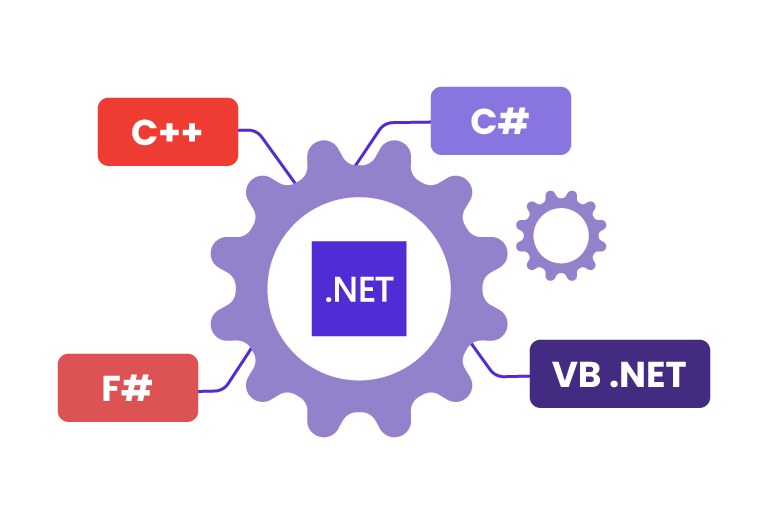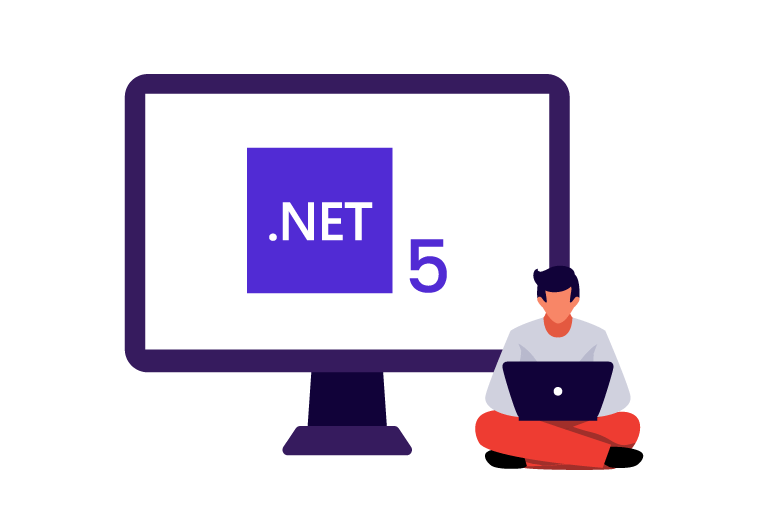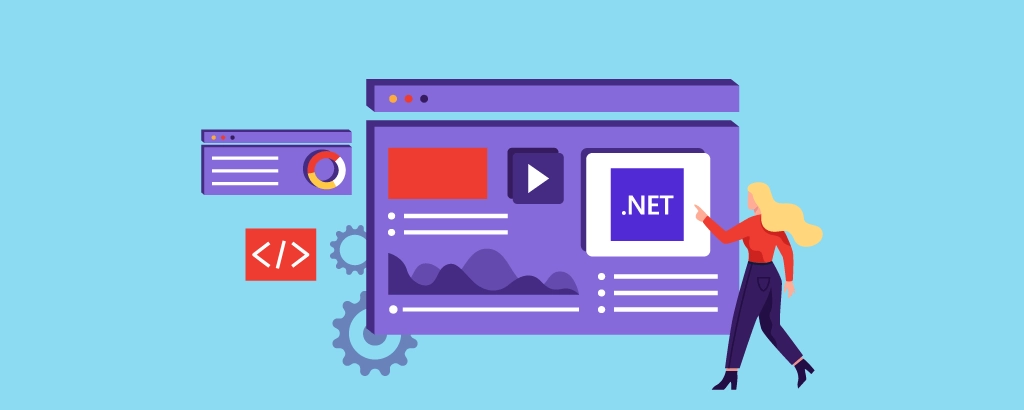Dot NET Software Development Takes Center Stage in the Global Spotlight
The business app development market is experiencing significant growth in both value and volume. In the midst of the noise and competition, you don’t want your web-based applications to get lost in obscurity. If you’re seeking to create accessible applications for the web, mobile, and Windows platforms, there’s one framework you can rely on: Dot NET. Developed by Microsoft Corporation and renowned for its ability to streamline the app-building process, Dot NET is the focus of our energetic discussion today. Join us as we delve into the power and potential of the Dot NET framework.
What is Dot Net Application Development?
.Net is a free, open-source platform used to drive the development activities, continuous operations and thorough maintenance of cross-platform apps. Wait, did I just say cross-platform? Well, that’s true.  Although its original design went around only to suit Windows applications, .NET framework architecture seems to have gone ahead in having macOS, Linux-oriented web, mobile, desktop and 2D/3D games under its hood. All thanks to .NET Core providing the runtime, compiler and library components that allow the implementation of .NET on all these platforms. The happy news is that they are available open-source on GitHub and also welcome contributions from developers. Building business applications with Dot Net Core also takes you to the cloud and IoT (Internet of Things). It gives developers additional freedom to code in a wide-range of 32 programming languages, the major ones being C++, VB.NET, C#, F#. Others in this list include Boo, Cobra, Sharp, IronPython and so on. Now, I can’t be sure if it is right to compare .NET with Java development. But it would be fair to say that .Net software development has lesser “vulnerable density” in terms of the defects in the sample code than Java. This means that it is comparatively secure – just in case you are planning to create an app for a banking or financial system. So, considering the languages, tools and technologies that .net framework embraces even today, you can definitely conclude that it is here to stay and create milestones for app creation, migration, QA and reengineering.
Although its original design went around only to suit Windows applications, .NET framework architecture seems to have gone ahead in having macOS, Linux-oriented web, mobile, desktop and 2D/3D games under its hood. All thanks to .NET Core providing the runtime, compiler and library components that allow the implementation of .NET on all these platforms. The happy news is that they are available open-source on GitHub and also welcome contributions from developers. Building business applications with Dot Net Core also takes you to the cloud and IoT (Internet of Things). It gives developers additional freedom to code in a wide-range of 32 programming languages, the major ones being C++, VB.NET, C#, F#. Others in this list include Boo, Cobra, Sharp, IronPython and so on. Now, I can’t be sure if it is right to compare .NET with Java development. But it would be fair to say that .Net software development has lesser “vulnerable density” in terms of the defects in the sample code than Java. This means that it is comparatively secure – just in case you are planning to create an app for a banking or financial system. So, considering the languages, tools and technologies that .net framework embraces even today, you can definitely conclude that it is here to stay and create milestones for app creation, migration, QA and reengineering.
The story behind Dot Net Core
As I’d previously mentioned that Dot Net Core was an attempt to take Dot Net across major platforms, you will want to know when this thought was first put to practice. Although the very first announcements of Dot Net Core was made in 2014, it was not until 2016 that it saw a major release. The initial launch laid its foundations on microservices and high-performance web apps. But the version 2.0 which was launched a year later, saw the addition of a number of APIs for the easy migration of web apps to Dot NetCore. Now, then came Dot Net Core 3.0 that guaranteed support for Windows desktop applications placing focus on Windows Presentation Framework (WPF), Windows Forms and UWP XAML. At this point, Microsoft had different plans for the future of Dot Net It was definitely time for a new name and a new Dot Net framework architecture altogether.
NET 5: About Dot Net development hereafter
.NET 5 can simply be called the idea of merging two strands into one- the familiar .NET framework and open-source .NET Core. Hence, developers can now work with any .NET version on all platforms  from Windows to mobile and the web. Microsoft has also made it clear that after .NET Core 3, there wouldn’t be any more releases that can port .NET Framework APIs. But what made Microsoft go ahead with this rather surprising move? To start with, the .NET framework has not been as competent as .NET Core as it was weighed down by the legacy of code. So, a merger would bring about optimization to the .NET ecosystem which was now more focussed on cross-platform development. But even when the .NET framework seems to slow down, it’s recorded to have a huge market share being operated on millions of Windows devices. Once merged with .NET core the entire .NET development will be able to take over web development across multiple platforms. The .NET Core possesses development tools that have the capacity to build more lightweight microservices using smart CLI and easy cloud deployment. Developers are huge fans of .NET Core so why not make the .NET framework to a part of their admiration.
from Windows to mobile and the web. Microsoft has also made it clear that after .NET Core 3, there wouldn’t be any more releases that can port .NET Framework APIs. But what made Microsoft go ahead with this rather surprising move? To start with, the .NET framework has not been as competent as .NET Core as it was weighed down by the legacy of code. So, a merger would bring about optimization to the .NET ecosystem which was now more focussed on cross-platform development. But even when the .NET framework seems to slow down, it’s recorded to have a huge market share being operated on millions of Windows devices. Once merged with .NET core the entire .NET development will be able to take over web development across multiple platforms. The .NET Core possesses development tools that have the capacity to build more lightweight microservices using smart CLI and easy cloud deployment. Developers are huge fans of .NET Core so why not make the .NET framework to a part of their admiration.
Keep up with these .Net development trends for 2020-21
With every web application platform constantly improvising itself, Microsoft is also sure to expand its .NET allies across to make some bigger changes. Well, why would it not? The Stack Overflow Developer Survey for 2019 indicates that .NET is indeed the most loved framework of the developer community. It’s definitely not easy to make it to the heart of developers, but simple to lose that of one. Owing to this factor, Microsoft’s announcement regarding the integration of its products-.NET framework and .NET Core – into a single platform .NET 5 remains by far the most sought after news about the .NET family. While .NET 5 makes a significant trend, let’s check out what else is brewing in the .NET trends for 2020-21.
Trending #1: Azure Cloud to float safely
Anything that is on the cloud is said to be safe and most importantly provides a huge storage capacity. Data in its manifolds can be stored and accessed from anywhere and at any time. Moreover, businesses are resorting to cloud technology simply because it frees them from setting up a local environment or systems to upgrade memory. Now, can Microsoft turn a blind eye towards its users? Definitely not! So, Microsoft implemented a cloud-based solution that has, fortunately, become a booming buzz today – the Azure! Companies switching to the Azure cloud claim that they can get Big data insights, security and private maintenance of data and a complete package of an analytics solution.
Trending #2: The tempting Blazor framework
Dreaming about interactive user interfaces for your client-side web apps with .NET? Then Blazor’s got your back. It is an open-source framework for single-page app development that uses C#, HTML and Razor instead of JavaScript. Blazor’s popularity has made it to strongly contend with JavaScript frameworks like Angular, Vue and React. Blazor with the help of Web Assembly performs without any additional plugins and add ons to back up. What gets Blazor on the trending list is it’s easier learning curve, code shareability, speed when placed side-by-side with market-leading JavaScript frameworks. Cheers to you Blazor!
Trending #3: ML.NET 1.4 for machine learning models
Now, you can develop machine learning features into your .NET applications with this all-new update of Microsoft called the ML.NET 1.4. With this update, machine learning analytics, predictive capabilities, customer segmentation and image classification are brought close to your apps. It’s open-source and cross-platform feature is much appreciated. If you are someone really serious about machine learning but have no clue about Data Science, ML.NET 1.4 gives you access to existing 3rd party models. Now, will anything stop you from adding this amazing ML.NET 1.4 to your development toolkit for 2020-21?
Trending #4: The most awaited .NET 5
While this is obvious, let’s not ignore .NET 5 and shower it with some praise it deserves. Everything is adorable with .NET 5 who adds the extra power to .NET application development. This .NET latest version lets you migrate to Blazor or other frameworks like the JavaScript React and Angular. It is extremely great to use with high support features also making it a part of many tech stacks like Winforms, WPF, UWP and so on. So, this isn’t really a .NET trend, but a must-have .NET update up your sleeve.
The Timeless Allure of the Microsoft Software Stack
Let’s not ignore the fact that new frameworks and libraries are tempting and it’s natural to get carried away by them. But do you know that Microsoft’s gravitational pull has been so strong that its giant .NET framework and the company as a whole shows no symptoms of old age? But what makes Microsoft so mature to handle real-world business scenarios so effectively? I’ll give you some reasons as to why Microsoft has always been and will always be a good idea.
- Very well, the first reason is our star of the show – the .NET software development ecosystem which supports some out of the box development tasks today. It’s libraries incorporate modern requirements like automated email delivery, Database connectivity and all of which are well-tested, documented and versatile.
- The SQL Server which has stood the test of time as a primary data keeper integrates fantastically with the Microsoft stack. Even the .NET framework works well with the SQL server which allows .NET code to be embedded as functions without sacrificing its performance.
- Testability is another factor that helps Microsoft have an edge over others. It comes well equipped with ASP.NET MVC that has hooks for dependency injection. Even the SQL Server has tools that come with templates for testing.
- The ASP.NET front-end underwent an evolution throughout these years with its MVC architecture. Web services get better exposure on a range of platforms including phones and desktops. The infrastructure guarantees authentication and integration even with other technologies like Bootstrap and Angularjs
- The Visual Studio is another reason to keep choosing Microsoft over and over. It has turned out to be a go-getter for hosting IDEs because both Microsoft and Non-Microsoft products can now integrate with Visual Studio. The peculiarity of Visual Studio ranges from being able to develop excellent user interfaces for iPad/Android apps to database development with SQL Server Tools.
Truly, Microsoft has been and will remain attuned to the realities of custom software solutions. After all, why would you say “no” to Microsoft if it can provide a significant Return on Investment without leaving a hole in your pocketbooks?
Outshine the business world with Pattem Digital’s Dot Net development.
Pattem Digital is known for carefully choosing customized and affordable Dot Net frameworks irrespective of the size and sector of your business. Our Dot Net development services foster professionals capable of transforming diverse business necessities into flexible and scalable solutions. Connect with our expert team today for a full-cycle Dot Net application development.


